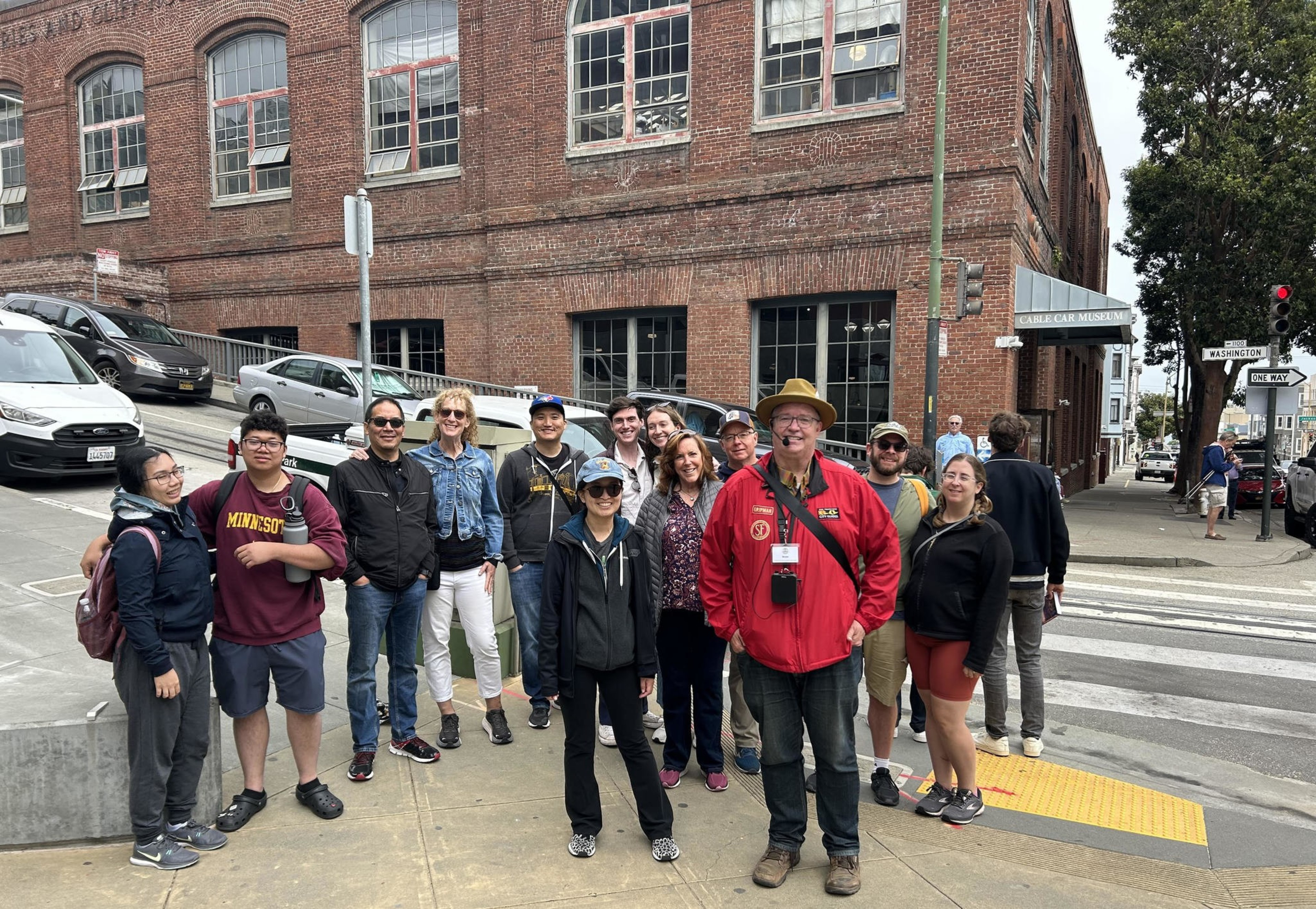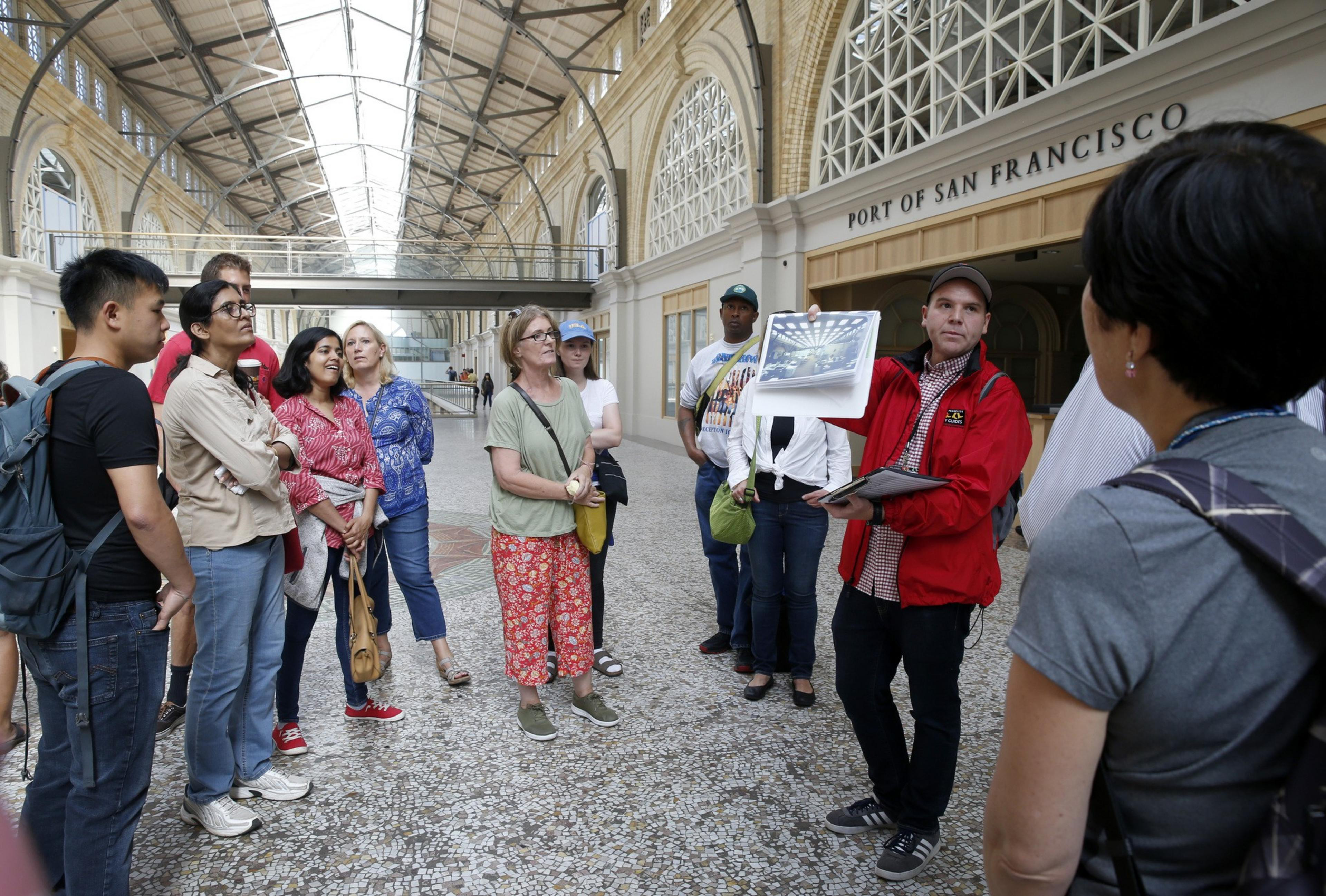There’s been a lot of doomsaying lately about the economic collapse of Downtown San Francisco. But this city has long been known as a place of booms and busts, going all the way back to the Gold Rush.
Turns out, you don’t need Google to learn more about the San Franciscans who have ridden a roller coaster of fortunes over the past couple of centuries. You need only sign up for City Guides’ free “Boom and Bust” tour of the Financial District (opens in new tab), offered on select afternoons throughout September.
“This has been a place where you could strike it rich, but it’s also been a place where you could lose it all,” reads the blurb for the tour, which is just one of a rotating array of organized guided walks that explore the city’s neighborhoods and history.
But many seasoned locals don’t know about this free resource at their feet, provided by a nearly half-century-old nonprofit that reveals the city in new ways.
“This is the real San Francisco,” said City Guides Executive Director Demetri Rizos. He touted the expert knowledge of the some 300 volunteer tour guides who lead the informative walks rain or shine, every day of the year.
“These are people who love this city,” he said.

Once you’re paying attention, you’ll notice the signature red jackets of the City Guides volunteers crisscrossing the city, groups of rapt pedestrians in tow. Walkers learn about subjects ranging from the circa 1920s and ’30s Art Deco architecture of the Marina to the 19th century gangs that controlled Chinatown.
Rory O’Connor trained to become a guide back in 2009 after catching the San Francisco history bug. “There’s so many really devoted and talented people,” O’Connor said. “With unique backgrounds and diverse interests.”
He recalls giving a tour to a group of property managers to various landmark banks Downtown.
“I couldn’t get them out of there, because they were so busy caressing the marble,” he said.
The origins of City Guides date back to 1976, when officials from the Mayor’s Office contacted librarian Gladys Hansen to request a tour of City Hall. The tour Hansen crafted was such a success that she began training additional volunteers to lead it, and two years later, City Guides was officially founded as a partner with the San Francisco Public Library.
What began with a single tour by a single guide has grown into today’s organization, with 300 volunteers who lead 70 unique excursions on everything from the birth of the Inner Sunset to secret spots in Golden Gate Park. The organization has continued its partnership with the library, which provides the group and its two paid staff members with office space.

Tours of the Haight, the Golden Gate Bridge and Chinatown are some of the most popular excursions, especially among tourists. But you’ll find many locals on the walks, too, in particular on more specialized neighborhood tours.
The organization is dynamic, constantly creating new tours and tweaking existing ones. Recent additions include “Climate Change at Crissy Field (opens in new tab)” and a cable car tour (opens in new tab) put together in honor of the 150th anniversary of the city’s signature mode of transportation.
The volunteer tour guides are responsible for generating new tour ideas that must go through a strict process (it took a year for Rory O’Connor to get his “Silent Film San Francisco” tour approved).
The training to lead the walks is also rigorous. Potential guides must attend and pay for a five-month training program and also agree to lead a set number of tours.
“Everything is because of our wonderful guides,” Rizos said.
Phil Bailey, who has been giving walking tours for two decades, met his wife on one 18 years ago.
“The ‘Gold Rush City’ tour is very near and dear to my heart,” Bailey said.
He’s had other memorable experiences, like meeting a group of drunken Australians who hadn’t been to bed for three days.
“They bought me a beer at the end because they felt so bad about their ancestors burning down the city,” Bailey said, referring to the arson of the criminal gang from Australia known as the Sydney Ducks (opens in new tab), which was blamed for setting a fire in 1849 that nearly destroyed the heart of San Francisco.
Tour guide Roger Hooson specializes in the “Gold Rush City” tour, which he’s been leading for 30 years. On a recent Wednesday, 16 people, a mix of locals and tourists, showed up for his afternoon walk.
Hooson pointed out spots that were once sand dunes and shared images of long-gone buildings from a binder of protective vinyl sheets. Participants also had the opportunity to inspect real-life objects when they ducked into a 1920s-era skyscraper at 343 Sansome St.
Gold Rush artifacts—unearthed during the development of the building next door—were on display in the lobby: brass weights with Chinese characters, daguerrotypes, ceramic ink bottles. Walkers learn the saying: “I’ve seen the elephant,” an expression 19th century gold-seeking hopefuls learned to mean they’d come home with empty hands but full of stories.
“The history of San Francisco is fascinating, and it continues to evolve,” said Tam Tran, who has been a City Guides tour leader for 20 years.
Tran started with the Mission Dolores tour, but her favorite is the tour of the Salesforce Transit Center.
“It’s very forward-thinking, about what’s happening Downtown,” Tran said, who is constantly updating her tour. “I thought I knew the city, but I’ve learned so much.”
